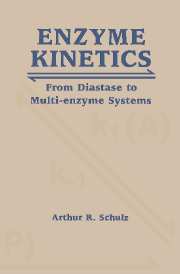Book contents
- Frontmatter
- Contents
- Preface
- Part One Basic steady state enzyme kinetics
- Part Two Enzyme reaction sequence
- Part Three Non-hyperbolic enzyme kinetics
- 11 The causes of non-hyperbolic enzyme kinetics
- 12 Analysis of non-hyperbolic enzyme kinetics
- 13 The effect of subunit interactions on enzyme kinetics
- Part Four Control of multi-enzyme systems
- Part Five Solutions To problems
- Author index
- Subject index
11 - The causes of non-hyperbolic enzyme kinetics
Published online by Cambridge University Press: 23 November 2009
- Frontmatter
- Contents
- Preface
- Part One Basic steady state enzyme kinetics
- Part Two Enzyme reaction sequence
- Part Three Non-hyperbolic enzyme kinetics
- 11 The causes of non-hyperbolic enzyme kinetics
- 12 Analysis of non-hyperbolic enzyme kinetics
- 13 The effect of subunit interactions on enzyme kinetics
- Part Four Control of multi-enzyme systems
- Part Five Solutions To problems
- Author index
- Subject index
Summary
Most of the enzymic reaction sequences which have been considered to this point have given rise to rate equations which describe rectangular hyperbolas. That is, the rate equations fall into a class of mathematical expressions called rational polynomials of the order 1:1. However, those reaction sequences which were characterized by substrate inhibition gave rise to rate equations which did not describe rectangular hyperbolas, but which were rational polynomials of order 1:2. Thus, in the latter cases, the rate equation consisted of a numerator which contained the concentration of the substrate to the first power while the denominator contained the concentration of the substrate to the second power. A slight modification of reaction sequences which have already been discussed can give rise to rate equations which are rational polynomials of even higher powers. The majority of the enzymes which exhibit non-hyperbolic kinetic behavior are allosteric enzymes or polymeric enzymes in which the subunit interactions exhibit either positive or negative cooperativity. Subunit interactions will be discussed in chapter 13. In the case of allosteric enzymes, the enzyme contains an allosteric site which is distinct from the active site. It must be understood that kinetic studies do not offer proof of allosterism. Conclusive evidence of a separate allosteric site must be obtained in studies of the physical structure of the enzyme.
Random enzyme reaction sequences
One explanation for an ordered binding of substrates to an enzyme is that the binding of the first substrate to the enzyme induces a conformational change in the enzyme such that the active site of the enzyme is in a proper configuration to allow the second substrate to bind properly.
- Type
- Chapter
- Information
- Enzyme KineticsFrom Diastase to Multi-enzyme Systems, pp. 133 - 139Publisher: Cambridge University PressPrint publication year: 1994



